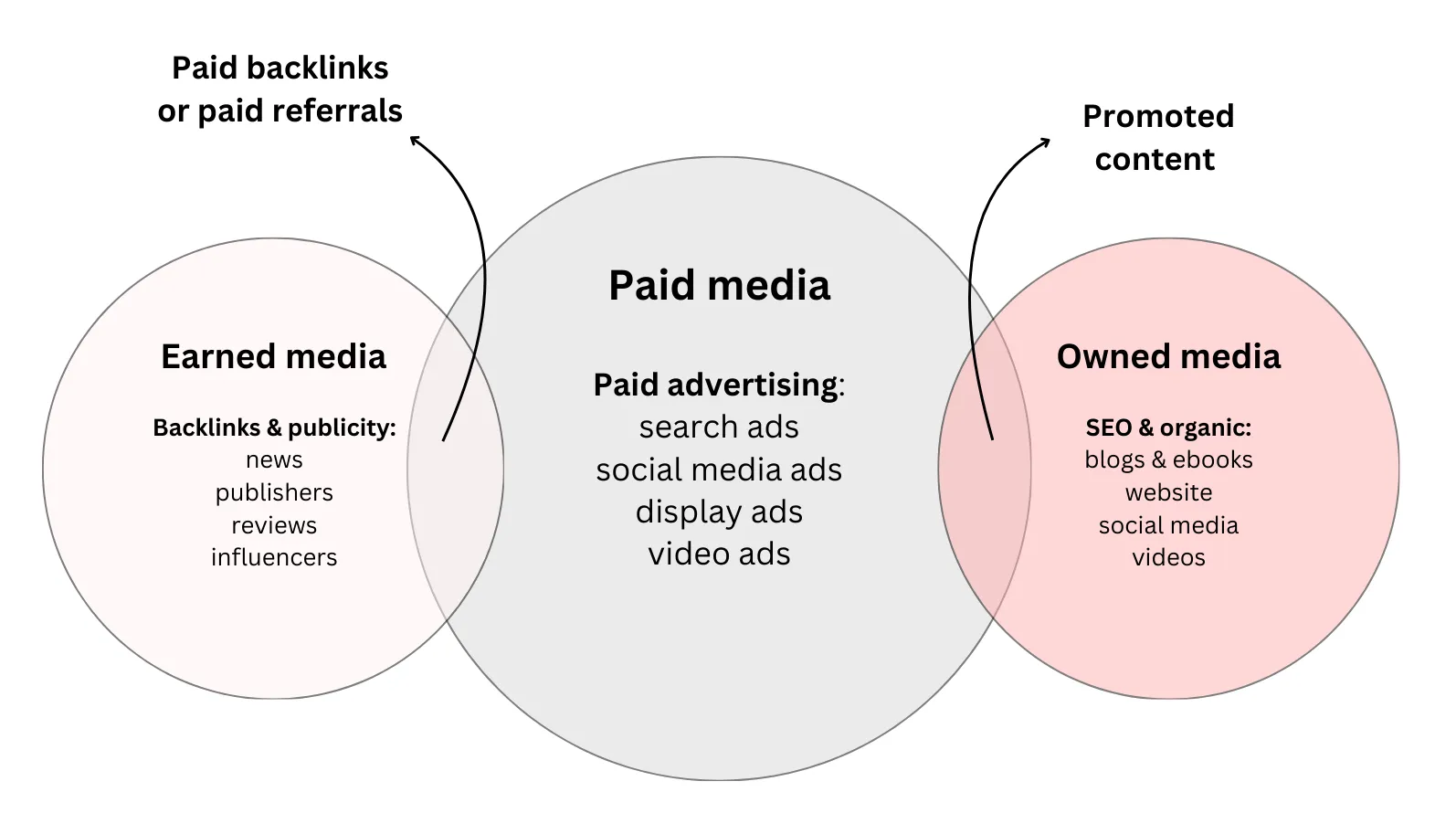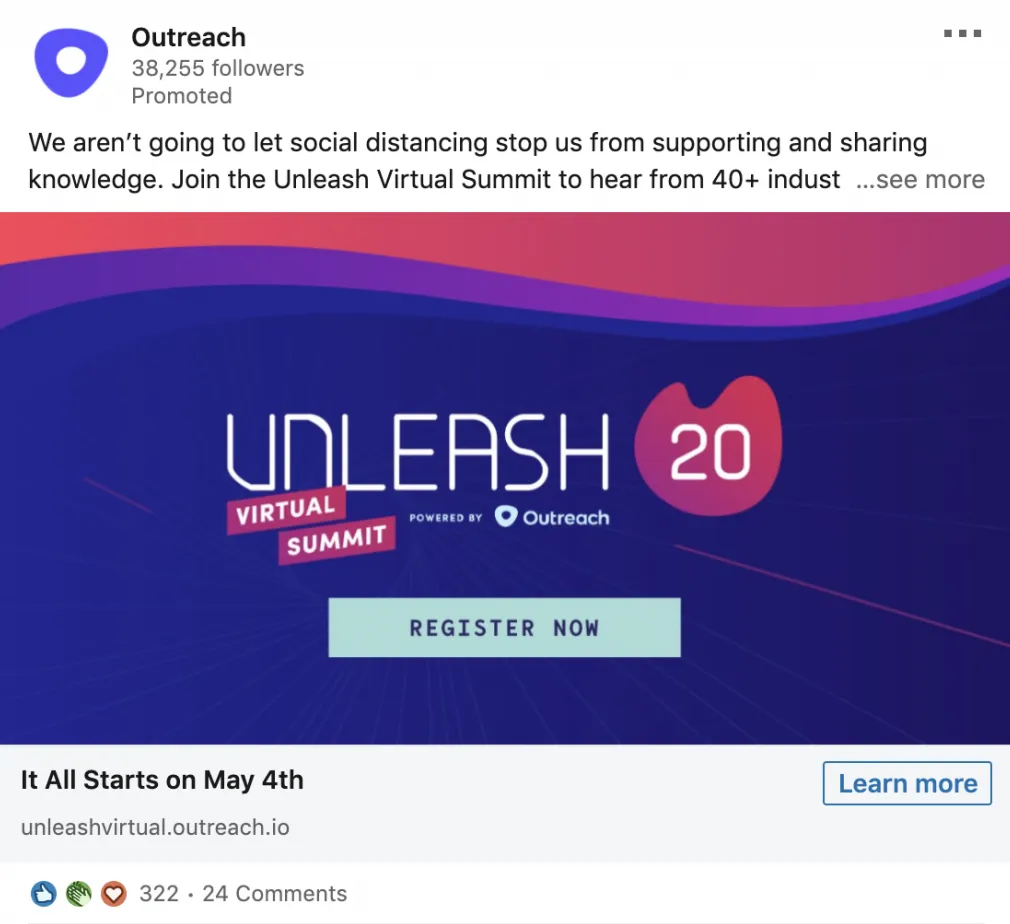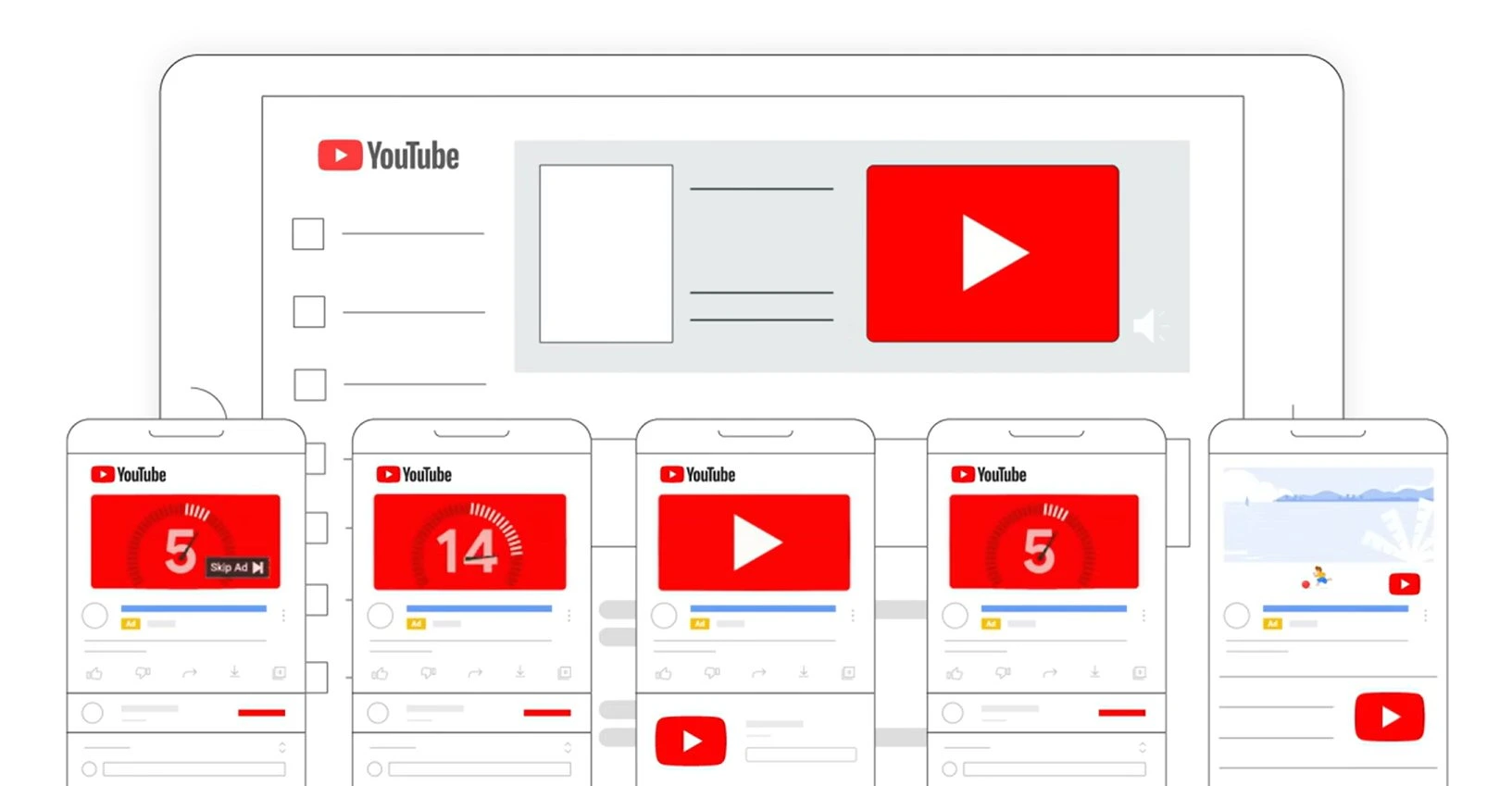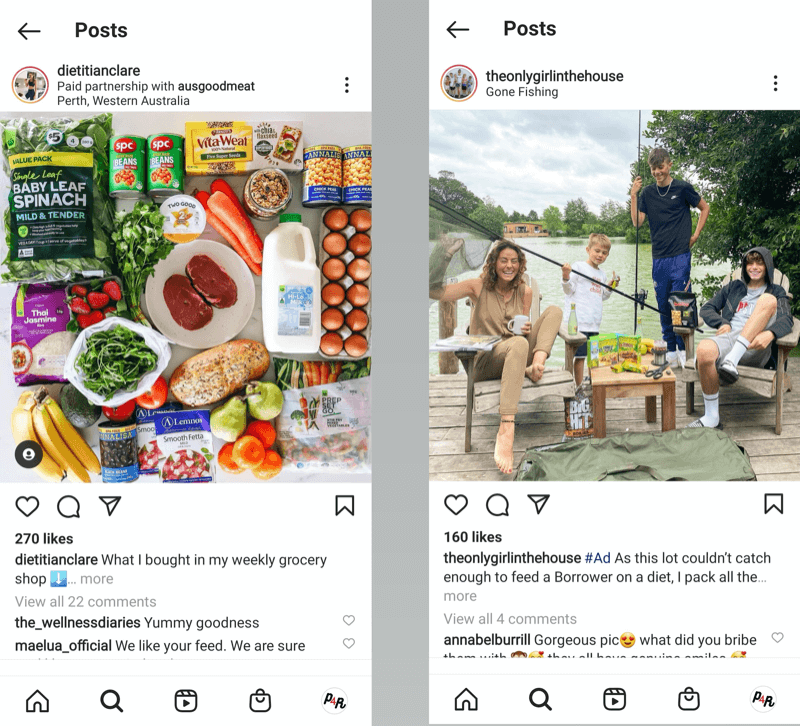About 5.4 billion people in the world are internet users today which is constantly growing at a rate of 3.2% every year. Growth of digital media and content consumption has been exponential in the past few years with no sign of slowing down whatsoever.
This creates a pool of opportunities for businesses looking to push their online presence but the downside is that this pool can feel infinitely large when you’re in it. It’s like screaming into a void and hearing nothing back—this is what paid advertising or paid media can feel like most of the time. But there’s a method to the madness and those who figure this out can reap the benefits.
What is paid media?
As a startup, building a marketing strategy is non-negotiable but the strategy itself entails extensive research, setting goals, priorities, audience preferences, and maybe even personal biases.
The first step to building an online presence is with content—be it your website, blog, social media, etc. Once you have this, the next step is to get people to notice it. People who resonate with what you have to say or the service that you offer will become a part of your journey as customers until they stop seeing value in it. This, in a nutshell, is the lifecycle of a company today and you have to be a part of it too.
Now, paid media is a part of digital marketing or advertising where you pay to feature your content to a relevant audience. Essentially, paid media campaigns help you become digitally visible to targeted users in exchange for the price you pay for it. It’s like buying a digital space to grow your business online. Digital paid media includes Pay-Per-Click (PPC) advertising on SERPs like Google, social media advertising on platforms like Meta, display advertising on websites, and video ads on platforms like YouTube. The boundaries of paid media also extend to offline methods like brochures, banners, billboards, TV ads, etc., but for the purposes of this blog, we will stick to digital paid media only.
Types of media can be categorized into 3 primary channels:
- Paid media: Growth from advertising your content and services on digital platforms.
- Earned media: Growth from referred or partner channels such as word of mouth, backlinks, reviews, etc., that you get organically.
- Owned media: Growth from organically owned content and SEO such as blogs, videos, website copy, ebooks, social media presence, etc.
Real-world examples of paid media in action
- Google Ads is used by startups like Zapier to capture high-intent users searching for automation tools.
- Meta Ads (Facebook + Instagram) help DTC brands like Glossier reach younger audiences with strong lifestyle visuals.
- LinkedIn Ads are leveraged by B2B companies like HubSpot to run lead gen campaigns targeted at marketing managers and executives.

A visual representation of paid, earned, and owned media and what lies at the intersection of it
Types of digital paid media
Digital paid media comes with options for you to decide where you’d like to promote your content or service. Various factors influence which platform to choose like goals, budget, target, and audience. Let’s look at some of the most commonly used paid media channels today:
Search engine ads
Search engine ads are one of the more commonly used advertising platforms where you can pay to have your ad appear on SERPs like Google or Bing when the user performs a search. Paid search or search engine advertising is intent-based and targeted as you can choose keywords for which your ads should rank.

Example of a paid search on Google created with Google Ads
Social media ads
Running ads on social media is great if your primary goal is to create brand awareness as well as generate customers. You can target people based on interests and demographics to narrow down your target audience effectively. Social media platforms like Meta, LinkedIn, and TikTok are great examples of where you can advertise.
In terms of the types of ad formats you can use on social media, you can create single-image ads, multiple-image ads like carousels, and even video ads. You can also promote an organic post directly.
YouTube is a great platform for running video ads as this is one of the most engaging, creative, expressive formats to improve interaction and conversion.

Example of a social media ad on LinkedIn
Display ads
The ads you see as banners, pop-ups, wallpapers, and even videos when you open a webpage are examples of display advertising. These can be quite affordable but are known for having lower click-through rates (CTR) as users rarely click on them. However, they can be a good way of branding.

Example of a display ad as a banner
Video ads
Video ads are a powerful form of paid media that let you deliver dynamic, visual messages through platforms like YouTube, TikTok, and in-stream video networks. These ads appear before, during, or after video content, or as standalone promoted videos in feeds. Video advertising is highly engaging and ideal for storytelling, emotional appeal, or product demos. You can target users by interests, search behavior, demographics, or even specific channels.

Video ad by YouTube
Influencer partnerships
Influencer partnerships are a form of paid advertising where brands collaborate with creators who have engaged audiences on platforms like Instagram, YouTube, TikTok, or LinkedIn. These creators promote the brand through sponsored content, stories, or reviews. Influencer ads work especially well for trust-building and niche targeting, since messages come from personalities users already follow. Partnerships can be paid per post, performance-based (e.g., affiliate), or built around long-term ambassadorships.

Influencer Partnership ad on Instagram
How do you decide what’s best for you?
When you’re starting from scratch, earned and owned media seem like the most sustainable option, and no doubt, they are. But generating content and building an organic channel require months if not years to yield any sort of tangible or dependable results. Not to mention the gargantuan effort it takes to lift organic channels off the ground.
This is where paid media can be a great way not just to get early traction but also to test the waters and see how receptive your audience is to the idea. This allows you to evolve and adapt quickly, aligning yourself with the needs of your potential users and optimizing ads (and your brand) for better results. Organic mediums are slow and difficult to steer whereas paid media gives you more control over how you position yourself. Paid media works perfectly because:
- Making changes to ads is easier and gives you an opportunity to improve important metrics like impressions, clicks, and conversions.
- Digital advertising is a lot more diverse in this day and age which increases your surface area of success by giving you control over where, how, and what you advertise
Is paid media right for you?
Having said what we just said, paid media isn’t easy. In fact, a lot of people quit paid advertising as quickly as they start because they don’t see any results.
- According to a source, the Cost-per-click (CPC) for most ads has increased by more than 10% on average across most industries which is making it more difficult for smaller startups to go against larger enterprises in a bidding war.
- A lot of consumers also suffer from ad fatigue (a result of seeing too many ads on platforms) and that leads to them ignoring or scrolling without paying any attention.
- It can take at least 3 months to see any concrete evidence of whether or not paid media is working for you—ad platforms need to learn about your ads just as much as you do.
Pay close attention to ROI because not keeping a check on your ad spend will force you to burn through your budget with nothing to show for it. A good way to ensure profitability through paid media is to keep customer lifetime value (LTV) above the customer acquisition cost (CAC).
Let’s take a few real-world examples
In this post, a startup founder talks about how, despite generating upwards of $18,000 in monthly revenue, they can’t afford to run ads because of low customer LTV which can be indicative of problems like poor retention and operational overheads.
This is an example of how not optimizing your ads can lead to lower revenue recognition over time. Paid media is a game-changer but it’s not a one-time effort; it’s a constant effort of understanding your ad performance and then deciding what to do. You have to take into account competition, what tone to use with your target audience, conversion actions they’re comfortable with, ad messaging, budget, goal, traffic, impressions, clicks, drop-offs—everything is interlinked and this intricate fabric of paid media is not necessarily difficult to navigate but definitely demanding of your attention.
A fintech startup that we worked with, Venn, hadn't achieved consistent results with Google Ads. We found that paid advertising was working for competitors so there’s opportunity for them as well. However, Venn being a startup, had to go up against legacy banks with established brand awareness. We identified keywords and unique selling point (USP), analyzed competitor ads, and hand-crafted ad copies that would convert. Through optimizations and performing intricate analysis, we were able to help them get 10x higher ROAS with conversions going up by 47% within a month.
However, if you do want to experiment with things yourself, here are some things we’d recommend.
Getting started with paid media
Setting goals
As a startup, you get to start with a blank canvas—choose what your priorities are in terms of marketing. In a nutshell, there are 2 common goals you can choose from:
- Creating brand awareness where impressions matter the most.
- Getting more conversions where you define what that conversion means i.e. making a sale, downloading an app, registering for an event, getting more website traffic, etc.
Choosing a paid media platform
After you’ve set your goals, you can then choose which paid media platform you want to go ahead with.
- If your goal is leaning more towards creating brand awareness—social media ads might be the best option although it’s not limited to just creating impressions.
- There are many social platforms including Meta, LinkedIn, and TikTok to name a few. Each of these platforms has a different demographic with different interests and intentions. For example: if you are a clothing brand, Instagram is far more relevant than LinkedIn to run ad campaigns.
- You can also run video ads to create brand awareness such as on YouTube and TikTok. In fact, video ads work better on these platforms than image ads.
- If your goal is to get more conversions and your target audience is solution-aware, search would be a good option to get higher conversion and acquisitions.
- Google is the most used search engine so it’s best for running search ads. This entails heavy keyword research to avoid expensive competition while still targeting keywords with decent volume for any substantial growth.
- There are certain nuances to search ads as well. As a startup building a new category, there might not be much search volume for intended keywords in which case search ads won’t pull in results. You can consider creating brand awareness and educating your target audience first and then move to search ads when you see considerable search volume.
Budgeting
A lower budget means that the ad platforms need much more time to optimize your campaigns, slowing down how you learn and make decisions based on them.
Counterintuitively, having a higher budget doesn’t work for a lot of reasons. Let’s take Google search for example—if targeting isn’t right, messaging isn’t strong, or there’s too much competition, then you end up spending too much to justify the conversions. If your keywords lack intention (broad match type keywords) then ads show up for irrelevant searches which further degrades the performance of your ads. It can also happen that your budget doesn’t get spent at all in case if keywords have low search volume altogether. For social ads, a higher budget (especially for a smaller audience) can cause the ad to show up frequently for the same audience which can lead to ad fatigue and a negative impression of your brand.
Budgeting is a tightrope to walk because a lot of factors influence this decision. Even the platform you choose is directly linked to the budget you decide on because some channels can be more expensive than others:
- Google has an average CPC between $0.11 to $0.5
- While ads on Meta can range from $0.20 to $0.30
- LinkedIn can be more expensive with an average CPC of $5.26 and TikTok recommends a $30 minimum daily ad budget.
Goals, target audience, and budget are primary factors to get started with a paid media campaign. Where your competitors are running ads is also a great way to figure out which platform suits you. A combination of these gives you a good place to start.
TL;DR
- Paid media is elaborative extremely diverse, meticulous, and vast; don’t dive in head first but rather start with structured steps that align with your objectives.
- Don’t rush; give yourself at least 3 months’ worth of space to experiment, observe, and optimize in terms of budget, channels, and collaterals.
- Consider exploring multiple platforms at once. Compare what works and what doesn't. Optimize for better results. Smartsheet, a work management platform, has seen an 8% increase in their CTR simply by changing the copy in a headline and a few words in the ad description.
FAQ
What is an example of a paid media strategy?
What is a paid media strategist?
How to build a paid media strategy?
What are the 5 M's of media strategy?
We know, it’s not that easy
When it comes to its practicality, paid media trickles down into more buckets than we can write about in one article. We hope this article brought some value to you but if you’re still skeptical about things, we’re here for you. From strategizing to results—Kaya specializes in everything you need to succeed as a startup. We’ll work as an extension of your team to give you 10x faster results.
- There’s a lot that comes with building a startup. We’ll help you with everything under the sun when it comes to advertising—from ideation and strategy to results and growth.
- Create dashboards that give you a transparent view of your ads—how are they performing, important KPIs, analytics, and ROI.
- End-to-end task management tool so you can spend time on growth and not time managing projects.


